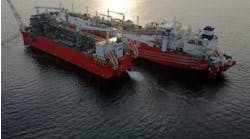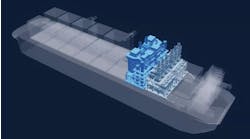Statoil concept's all-weather durability interests operators in Europe and Asia
The search for cost-effective production solutions for marginal and deepwater fields has produced a new concept - Statoil's submerged turret production (STP) system. In contrast with other production ship concepts, this one has been developed from the shipping side. The technology is based on the successful submerged turret loading (STL) system which has been chosen for a number of North Sea fields.
At the heart of STL is a submerged buoy which is pulled into the bottom of the tanker hull and connected to the shipboard systems. Because the whole loading system is under water, operations can continue even in very severe weather conditions.
According to Helene Olsson, a staff engineer with Statoil's Marine Technical Department, it was a logical development to examine whether the STL technology could be adapted to handle the wellstream coming directly from subsea wells.
The principal requirement was that the connector, the pivotal link between the buoy and the ship, would have to be able to handle the flow from a number of flexible risers, allow the re-injection of gas and the injection of water and methanol, and permit the operation of the subsea facilities through high-pressure hydraulic, electrical power, and signal lines.
The solution was found in the shape of a rotating connector developed by Framo Engineering, which drew on its extensive experience in subsea and multiphase pumps.
The connector is based on an insert technology and incorporates a flexible seal which can handle forces in all directions. Machine and seal elements are already proven in use for similar duties.
The male part of the connector is mounted within the ship and the female within the buoy. All operations inside the compartment in which the two parts are mated are unmanned, and the area may be perged by inert gas and sustain being submerged in sea water. Any critical failure is isolated within the compartment.
In August last year, a full-size prototype connector was installed at Framo's works in Bergen. A full testing program was executed, demonstrating, among other things, that both connection and disconnection could be carried out in a matter of minutes.
The program included tests with a crude stream designed to simulate a high pressure well, and with sand, water, and gas. Flexibility has also been built into the process side. Standard equipment is used in a modular form, making it easy to add or take away equipment as required. For safety reasons the process deck is placed 3.5 meters above the main deck.
The anchor system, which is connected to the bottom of the shaft up which the buoy is pulled during mating has been successfully tested for water depths up to 1,500 meters, meaning that the vessel could be used for the production of remote, deepwater fields. In production ship mode, the vessel would require an overall crew - marine and operations personnel - of only 30-35.
"It's been a very fast development," says Olsson. "Work on the connector started only one and a half years ago."
The STL system is now taking material form in the shape of the 103,000 dwt multipurpose shuttle tanker, recently ordered by Statoil and shipowner Bergesen from the Samsun yard in South Korea.
The vessel has the flexibility to be used as a storage unit, an offshore loading unit, a shuttle tanker, and a production ship. However, production equipment does not form part of Samsun's construction contract.
The vessel's multiple functions enhance its chances of finding work and repaying its investment. When it is not wanted in any of its other roles, Statoil, as the world's leading shuttle tanker operator, is well placed to find it work in this role. But Olsson is confident of the Statoil/Bergesen vessel's chances of winning work as a production ship.
"When the ship leaves the yard in the third quarter of next year, I think we'll have a production contract," she says. "There's a great deal of interest in this concept, particularly in Norway and Asia."
Meanwhile the STL system is already in operation on Shell's Fulmar Field, and is to be used in three other fields - Conoco/Statoil's Heidrun, Statoil's Yme, and BP's Harding. By the end of this year, eight tankers will be in operation equipped with the system.
Copyright 1995 Offshore. All Rights Reserved.


